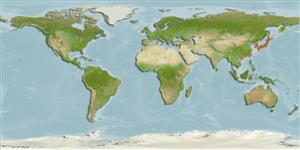Common names from other countries
Environment: milieu / climate zone / depth range / distribution range
Écologie
; saumâtre; profondeur 0 - 6 m (Ref. 385). Subtropical
Distribution
Pays | Zones FAO | Écosystèmes | Occurrences | Introductions
Northwest Pacific: from south of Japan to the south of Sakhalin.
Length at first maturity / Taille / Poids / Âge
Maturity: Lm ?, range 2 - ? cm Max length : 4.0 cm SHL mâle / non sexé; (Ref. 127304); âge max. reporté: 10 années (Ref. 127304)
Found in subtidal areas of estuaries in mud (Ref. 75831). Infaunal suspension-feeder (Ref. ).
Life cycle and mating behavior
Maturité | Reproduction | Frai | Œufs | Fécondité | Larves
Life cycle: Embryos develop into free-swimming trocophore larvae, succeeded by the bivalve veliger, resembling a miniature clam (Ref. 833).
SAUP Database. 2006. (Ref. 356)
Statut dans la liste rouge de l'IUCN (Ref. 130435)
statut CITES (Ref. 108899)
Not Evaluated
Not Evaluated
Utilisations par l'homme
Pêcheries: commercial
FAO - pêcheries: landings, species profile | FishSource | Sea Around Us
Outils
Sources Internet
Estimates based on models
Preferred temperature
(Ref.
115969): 5.6 - 22.6, mean 14 (based on 372 cells).
Résilience
Haut, temps minimum de doublement de population inférieur à 15 mois (K=0.2-1.11; tm=3; tmax=10).
Catégorie de prix
Unknown.
